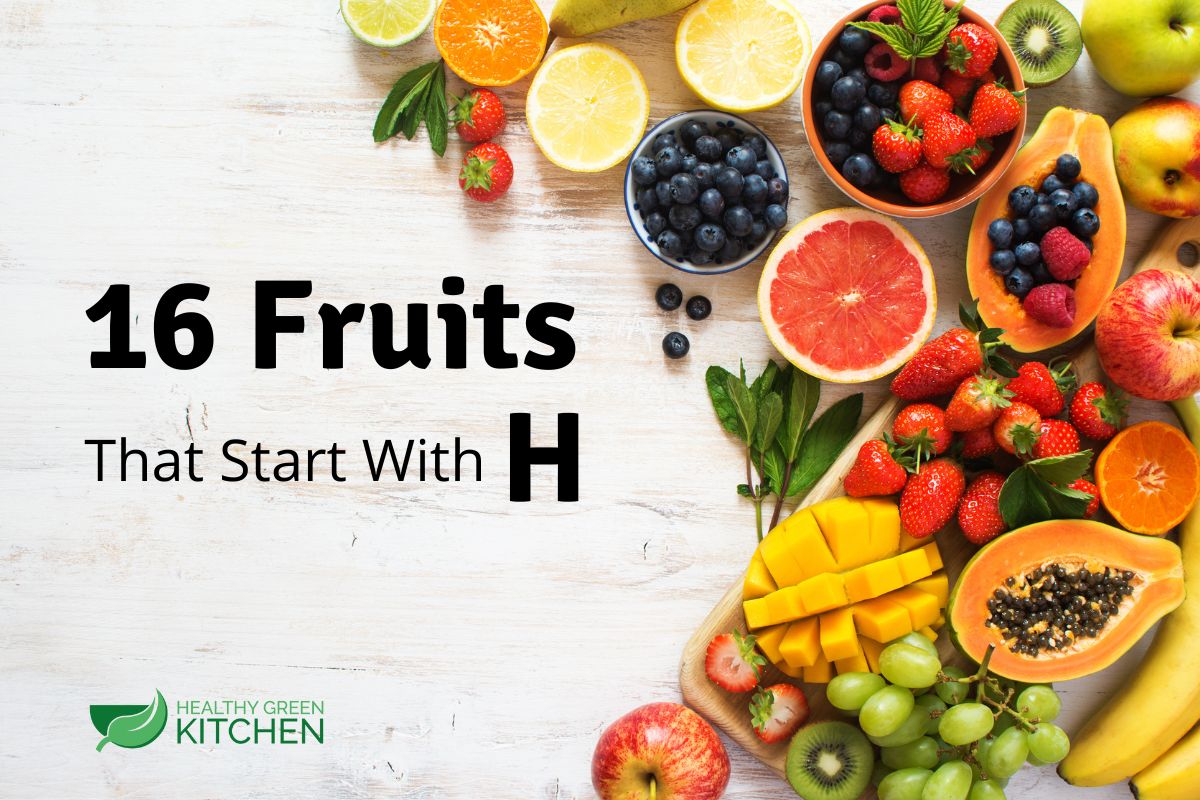
There are many delicious fruits that start with H.
You might recognize some of them, like honeydew and huckleberries, but we hope you discover a few new ones on this list. For example, did you know there are fruits with the name hairless rambutan or horned melon?
Intrigued to learn more? Keep reading this list of fruits that start with H to discover your new favorite.
1. Hala Fruit
Hala fruit has to be one of the prettiest fruits on this list.
It has a rough exterior similar to a pineapple. When you cut into the fruit, each knob has a visual ombre effect and ranges in color from yellow to green.
These segments have edible flesh that tastes like a cross between a pineapple and a mango. However, most of the fruit is unedible, making it expensive by the pound.
2. Hawaiian Mountain Apple
Hawaiian mountain apples resemble the Red Delicious variety commonly found in American grocery stores. They are bell-shaped with waxy red skin that’s remarkably shiny.
However, if you sink your teeth into a Hawaiian mountain apple, expect a delicate sweetness that tastes more like a pear.
You’ll find this shiny fruit in low-lying valleys and tropical forests throughout the island. Despite the name, this fruit variety is actually native to Malaysia.
3. Hawthorn Berry
The hawthorn variety has several other names, including quickthorn, thornapple, hawberry, and whitethorn. This species produces small berries that typically range between ruby red and orange-yellow.
These bright red berries contain many antioxidants and have been traditionally used as a natural medicine for digestive issues.
You can expect a tart, sour taste, so you’ll likely find these berries used in jellies and sauces.
4. Himalayan Mulberry
At first glance, you might mistake a Himalayan mulberry for a caterpillar. This unique variety grows downward to form long, skinny fruit with tiny stems.
These berries are dark purple and rich in antioxidants. They have a juicy flavor with candy-like sweetness.
Contrary to the name, Himilayan mulberries are actually native to India and China.
5. Hog Plum
You might confuse hog plums with the common pear since this fruit has pale-yellow skin and freckles, but the taste is very different.
If you pluck a hog plum straight off the branch and take a bite, you’ll be taken aback by sour, tangy flavors similar to a Granny Smith apple. Since this fruit is more sour than sweet, you’ll typically find it used in wine, juices, and jellies, where sugar can offset the intense flavor.
6. Hackberry
The hackberry originated in the American midwest, where Ingenious peoples often used it for medicinal and ceremonial purposes.
The pea-sized, red berries grow high in the trees, making them hard to pick. For this reason, birds are the primary consumers of hackberries.
These berries have a high sugar content and taste sweet, that is, if you can get past the crunchy shell.
7. Hardy Kiwi
The hardy kiwi resembles the same green fruit you’ll find in the grocery store, complete with the same fuzzy skin, except for a few key differences.
For one, you can eat the hardy kiwi whole, skin and all, without having to peel beforehand. This variety is also smaller and oval-shaped.
You can also grow these fruits in colder climates, proving that this variety really lives up to its name.
8. Hazelnut
You might be wondering what hazelnut is going on this list of fruits that start with H, but did you know that tree nuts like hazelnut technically qualify as fruits?
You might commonly associate hazelnuts with delicious sweets like Ferrero Rocher or Nutella since this nut has an unforgettable sweet flavor.
However, did you know that this nut is a nutritional powerhouse? Hazelnuts contain a high amount of omega-3s and antioxidants, which benefit overall health. You’ll also find a hefty amount of fiber and protein in each serving.
9. Honeyberry
Honeyberries look like a mutant strain of blueberries when in fact, they’re actually part of the honeysuckle family. This plant is native to Russia and has an impressive tolerance to cold temperatures.
The honeyberry tastes like a hybrid between a raspberry, a blackberry, and a blueberry. You’ll find that the flavor is tart, juicy, and sour.
If you’re a fan of mouth-puckering fruit, this is the berry for you. But if you stray from acidic foods, you’ll better appreciate this berry in desserts or ice cream.
10. Hyuganastu
Hyuganatsu is a Japanese citrus fruit that’s high in acidity and sourness. You may classify it as the Japanese lemon, but it’s much more complex than that.
For one, it’s actually sweeter than a typical lemon, and you can eat it whole (or sprinkled with sugar for the sour adverse).
It also has a higher oil content than other citrus fruits, making it great for cooking. In Japan, you’ll often find hyuganatsu juice in beer, sake, and condiments.
11. Huito
This fruit stems from South and Central America and has a unique attribute that sets it apart.
An incredible quality of the huito fruit is that its clear juice turns blue when in contact with skin. This neat feature made it popular in ancient times as ceremonial body paint.
The beverage industry has taken advantage of this chemical reaction and figured out how to use huito fruit as a natural coloring agent in drinks.
12. Horned Melon
This unique fruit goes by several names, including African horned cucumber, jelly melon, spiked melon, or, most appropriately, the cuke-a-saurus.
Whatever you decide to call it, you can’t deny that this fruit has some dino-like qualities that hail from prehistoric times.
In addition to its unusual appearance, the horned melon has an even more distinctive flavor. Some liken the taste to a crossover between passionfruit, banana, cucumber, and lime. The texture is jelly-like and juicy, which makes it a popular ingredient for sauces and jams.
13. Huckleberry
The huckleberry plant is a North American species that produces small purple fruit.
Indigenous people traditionally used these berries as food or medicine, but huckleberry’s uses have become more widespread over time. Today you’ll find them as a popular ingredient in desserts, sauces, and even cocktails.
These purple berries taste sweet and sour, similar to blueberries. Like the latter, huckleberries are also full of antioxidants and Vitamin C.
14. Honeydew
Honeydew melon is a mainstay in American supermarkets, but did you know this husky fruit is actually native to the Middle East?
The green melon didn’t reach Europe until the 15th century, before being brought to America by Christopher Columbus.
Honeydew is the sweetest of all melons and consists of 90% water. Despite its high moisture content, honeydew isn’t just empty calories. Each serving contains a modest amount of Vitamin C and potassium.
15. Hairless Rambutan
You might think this fruit variety flew here from another planet, given its unique appearance, but it’s actually just a variation of the rambutan fruit without the hair-like spines.
This rare fruit tastes somewhat grape-like with a hint of sourness. You’ll commonly find this variety in Southeast Asia.
16. Hottentot Fig
Hottentot fig is a South African plant variety best known for its brilliant purple blooms.
This species produces small figs that are sticky and sour with a pulpy inner flesh. You can eat these figs fresh, but the taste is more palatable when mixed with sugar.






